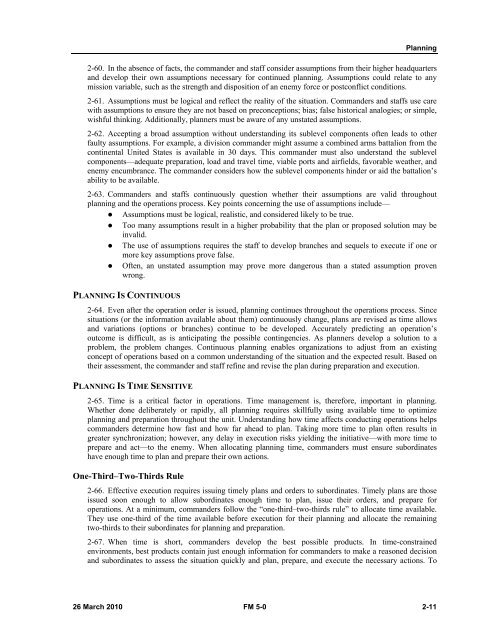FM 5-0, The Operations Process - Federation of American Scientists
FM 5-0, The Operations Process - Federation of American Scientists
FM 5-0, The Operations Process - Federation of American Scientists
You also want an ePaper? Increase the reach of your titles
YUMPU automatically turns print PDFs into web optimized ePapers that Google loves.
Planning<br />
2-60. In the absence <strong>of</strong> facts, the commander and staff consider assumptions from their higher headquarters<br />
and develop their own assumptions necessary for continued planning. Assumptions could relate to any<br />
mission variable, such as the strength and disposition <strong>of</strong> an enemy force or postconflict conditions.<br />
2-61. Assumptions must be logical and reflect the reality <strong>of</strong> the situation. Commanders and staffs use care<br />
with assumptions to ensure they are not based on preconceptions; bias; false historical analogies; or simple,<br />
wishful thinking. Additionally, planners must be aware <strong>of</strong> any unstated assumptions.<br />
2-62. Accepting a broad assumption without understanding its sublevel components <strong>of</strong>ten leads to other<br />
faulty assumptions. For example, a division commander might assume a combined arms battalion from the<br />
continental United States is available in 30 days. This commander must also understand the sublevel<br />
components—adequate preparation, load and travel time, viable ports and airfields, favorable weather, and<br />
enemy encumbrance. <strong>The</strong> commander considers how the sublevel components hinder or aid the battalion’s<br />
ability to be available.<br />
2-63. Commanders and staffs continuously question whether their assumptions are valid throughout<br />
planning and the operations process. Key points concerning the use <strong>of</strong> assumptions include—<br />
• Assumptions must be logical, realistic, and considered likely to be true.<br />
• Too many assumptions result in a higher probability that the plan or proposed solution may be<br />
invalid.<br />
• <strong>The</strong> use <strong>of</strong> assumptions requires the staff to develop branches and sequels to execute if one or<br />
more key assumptions prove false.<br />
• Often, an unstated assumption may prove more dangerous than a stated assumption proven<br />
wrong.<br />
PLANNING IS CONTINUOUS<br />
2-64. Even after the operation order is issued, planning continues throughout the operations process. Since<br />
situations (or the information available about them) continuously change, plans are revised as time allows<br />
and variations (options or branches) continue to be developed. Accurately predicting an operation’s<br />
outcome is difficult, as is anticipating the possible contingencies. As planners develop a solution to a<br />
problem, the problem changes. Continuous planning enables organizations to adjust from an existing<br />
concept <strong>of</strong> operations based on a common understanding <strong>of</strong> the situation and the expected result. Based on<br />
their assessment, the commander and staff refine and revise the plan during preparation and execution.<br />
PLANNING IS TIME SENSITIVE<br />
2-65. Time is a critical factor in operations. Time management is, therefore, important in planning.<br />
Whether done deliberately or rapidly, all planning requires skillfully using available time to optimize<br />
planning and preparation throughout the unit. Understanding how time affects conducting operations helps<br />
commanders determine how fast and how far ahead to plan. Taking more time to plan <strong>of</strong>ten results in<br />
greater synchronization; however, any delay in execution risks yielding the initiative—with more time to<br />
prepare and act—to the enemy. When allocating planning time, commanders must ensure subordinates<br />
have enough time to plan and prepare their own actions.<br />
One-Third–Two-Thirds Rule<br />
2-66. Effective execution requires issuing timely plans and orders to subordinates. Timely plans are those<br />
issued soon enough to allow subordinates enough time to plan, issue their orders, and prepare for<br />
operations. At a minimum, commanders follow the “one-third–two-thirds rule” to allocate time available.<br />
<strong>The</strong>y use one-third <strong>of</strong> the time available before execution for their planning and allocate the remaining<br />
two-thirds to their subordinates for planning and preparation.<br />
2-67. When time is short, commanders develop the best possible products. In time-constrained<br />
environments, best products contain just enough information for commanders to make a reasoned decision<br />
and subordinates to assess the situation quickly and plan, prepare, and execute the necessary actions. To<br />
26 March 2010 <strong>FM</strong> 5-0 2-11















